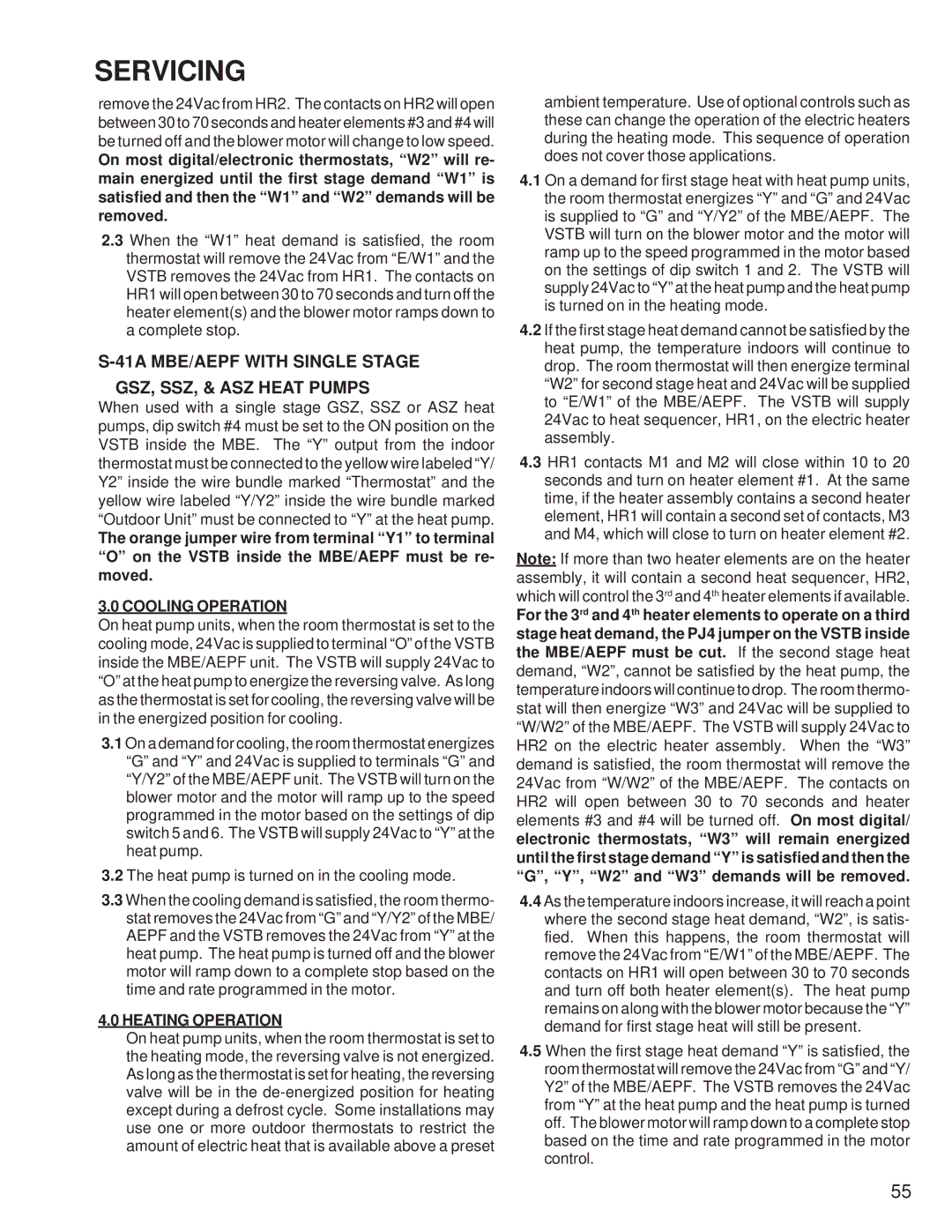SERVICING
remove the 24Vac from HR2. The contacts on HR2 will open between 30 to 70 seconds and heater elements #3 and #4 will be turned off and the blower motor will change to low speed.
On most digital/electronic thermostats, “W2” will re- main energized until the first stage demand “W1” is satisfied and then the “W1” and “W2” demands will be removed.
2.3When the “W1” heat demand is satisfied, the room thermostat will remove the 24Vac from “E/W1” and the VSTB removes the 24Vac from HR1. The contacts on HR1 will open between 30 to 70 seconds and turn off the heater element(s) and the blower motor ramps down to a complete stop.
S-41A MBE/AEPF WITH SINGLE STAGE GSZ, SSZ, & ASZ HEAT PUMPS
When used with a single stage GSZ, SSZ or ASZ heat pumps, dip switch #4 must be set to the ON position on the VSTB inside the MBE. The “Y” output from the indoor thermostat must be connected to the yellow wire labeled “Y/ Y2” inside the wire bundle marked “Thermostat” and the yellow wire labeled “Y/Y2” inside the wire bundle marked “Outdoor Unit” must be connected to “Y” at the heat pump.
The orange jumper wire from terminal “Y1” to terminal “O” on the VSTB inside the MBE/AEPF must be re- moved.
3.0 COOLING OPERATION
On heat pump units, when the room thermostat is set to the cooling mode, 24Vac is supplied to terminal “O” of the VSTB inside the MBE/AEPF unit. The VSTB will supply 24Vac to “O” at the heat pump to energize the reversing valve. As long as the thermostat is set for cooling, the reversing valve will be in the energized position for cooling.
3.1On a demand for cooling, the room thermostat energizes “G” and “Y” and 24Vac is supplied to terminals “G” and “Y/Y2” of the MBE/AEPF unit. The VSTB will turn on the blower motor and the motor will ramp up to the speed programmed in the motor based on the settings of dip switch 5 and 6. The VSTB will supply 24Vac to “Y” at the heat pump.
3.2The heat pump is turned on in the cooling mode.
3.3When the cooling demand is satisfied, the room thermo- stat removes the 24Vac from “G” and “Y/Y2” of the MBE/ AEPF and the VSTB removes the 24Vac from “Y” at the heat pump. The heat pump is turned off and the blower motor will ramp down to a complete stop based on the time and rate programmed in the motor.
4.0HEATING OPERATION
On heat pump units, when the room thermostat is set to the heating mode, the reversing valve is not energized. As long as the thermostat is set for heating, the reversing valve will be in the
ambient temperature. Use of optional controls such as these can change the operation of the electric heaters during the heating mode. This sequence of operation does not cover those applications.
4.1On a demand for first stage heat with heat pump units, the room thermostat energizes “Y” and “G” and 24Vac is supplied to “G” and “Y/Y2” of the MBE/AEPF. The VSTB will turn on the blower motor and the motor will ramp up to the speed programmed in the motor based on the settings of dip switch 1 and 2. The VSTB will supply 24Vac to “Y” at the heat pump and the heat pump is turned on in the heating mode.
4.2If the first stage heat demand cannot be satisfied by the heat pump, the temperature indoors will continue to drop. The room thermostat will then energize terminal “W2” for second stage heat and 24Vac will be supplied to “E/W1” of the MBE/AEPF. The VSTB will supply 24Vac to heat sequencer, HR1, on the electric heater assembly.
4.3HR1 contacts M1 and M2 will close within 10 to 20 seconds and turn on heater element #1. At the same time, if the heater assembly contains a second heater element, HR1 will contain a second set of contacts, M3 and M4, which will close to turn on heater element #2.
Note: If more than two heater elements are on the heater assembly, it will contain a second heat sequencer, HR2, which will control the 3rd and 4th heater elements if available.
For the 3rd and 4th heater elements to operate on a third stage heat demand, the PJ4 jumper on the VSTB inside the MBE/AEPF must be cut. If the second stage heat demand, “W2”, cannot be satisfied by the heat pump, the temperature indoors will continue to drop. The room thermo- stat will then energize “W3” and 24Vac will be supplied to “W/W2” of the MBE/AEPF. The VSTB will supply 24Vac to HR2 on the electric heater assembly. When the “W3” demand is satisfied, the room thermostat will remove the 24Vac from “W/W2” of the MBE/AEPF. The contacts on HR2 will open between 30 to 70 seconds and heater elements #3 and #4 will be turned off. On most digital/ electronic thermostats, “W3” will remain energized until the first stage demand “Y” is satisfied and then the “G”, “Y”, “W2” and “W3” demands will be removed.
4.4As the temperature indoors increase, it will reach a point where the second stage heat demand, “W2”, is satis- fied. When this happens, the room thermostat will remove the 24Vac from “E/W1” of the MBE/AEPF. The contacts on HR1 will open between 30 to 70 seconds and turn off both heater element(s). The heat pump remains on along with the blower motor because the “Y” demand for first stage heat will still be present.
4.5When the first stage heat demand “Y” is satisfied, the room thermostat will remove the 24Vac from “G” and “Y/ Y2” of the MBE/AEPF. The VSTB removes the 24Vac from “Y” at the heat pump and the heat pump is turned off. The blower motor will ramp down to a complete stop based on the time and rate programmed in the motor control.
55
